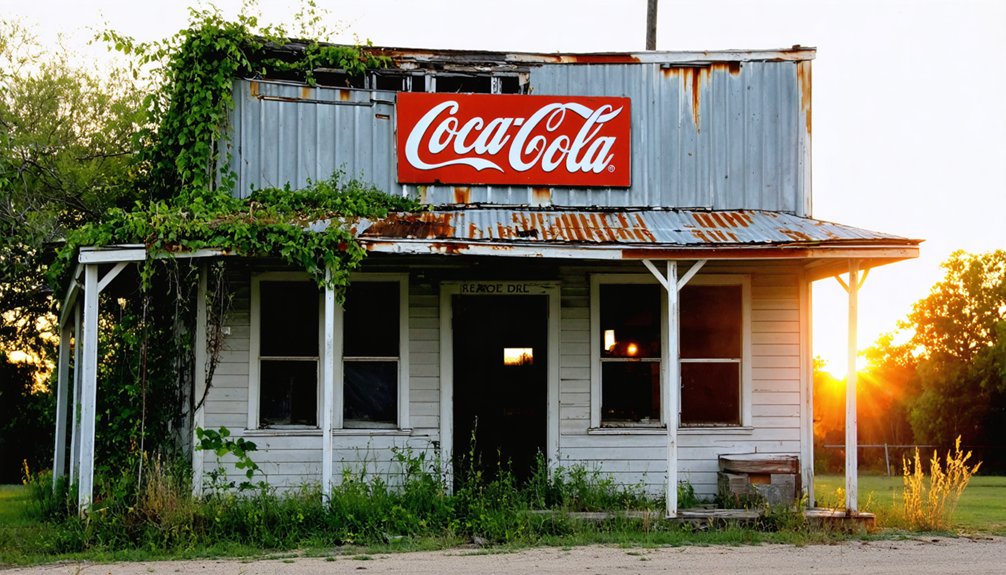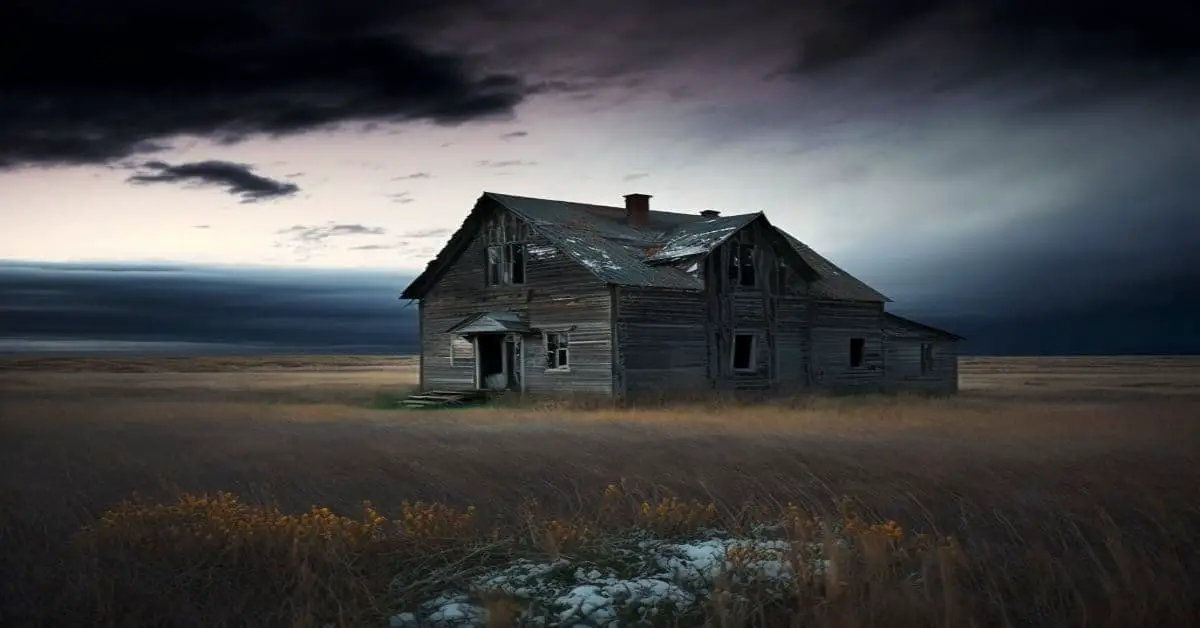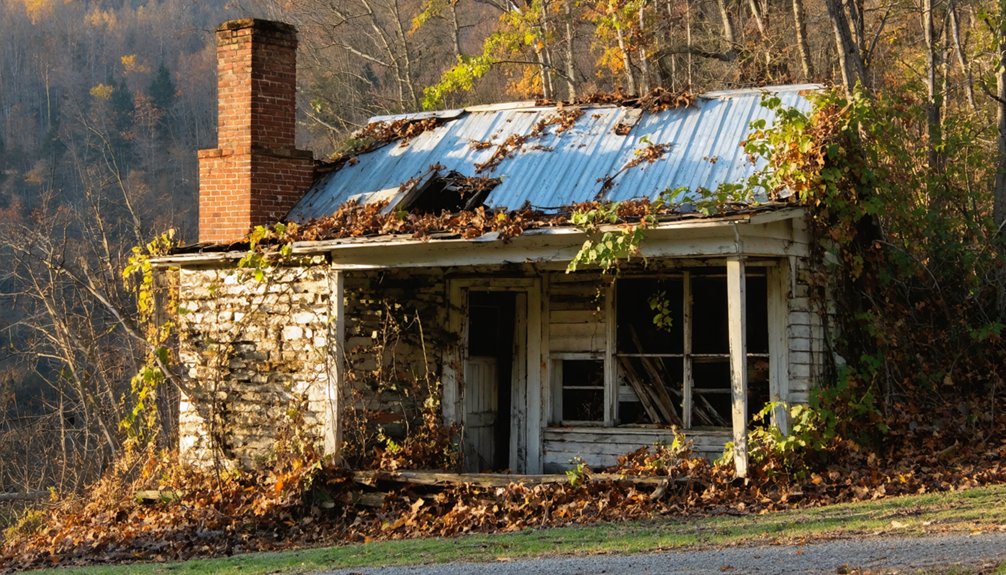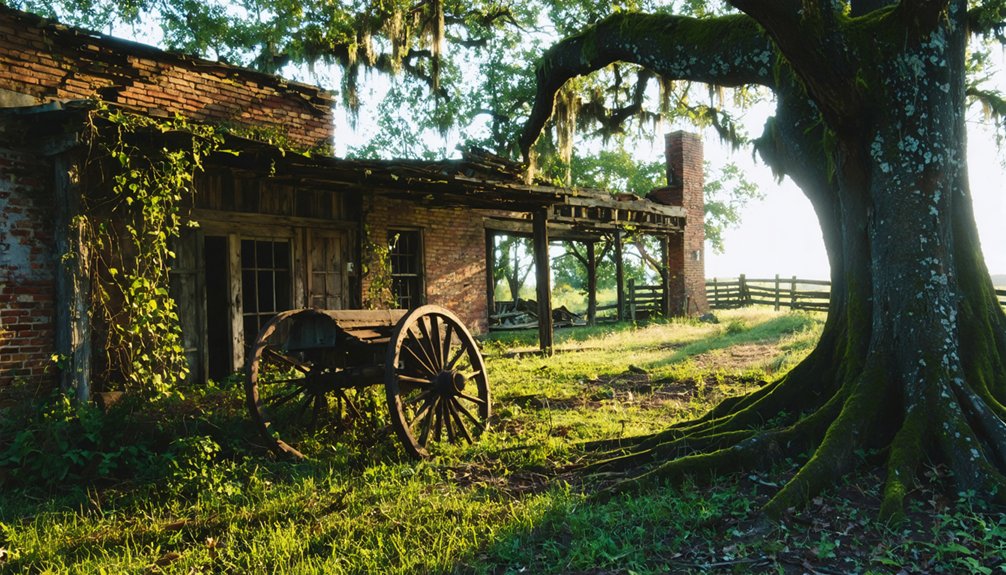You’ll find Daleville’s ghostly remains tucked away in Arkansas’s Ouachita National Forest, where a booming lumber empire once thrived in the early 1900s. At its peak, the Grayson-McLeod Lumber Company‘s mills churned out 150,000 board feet daily, while workers commuted from nearby Arkadelphia. Today, you can explore scattered foundations, an old cemetery, and abandoned rail lines that tell the story of this forgotten timber town‘s dramatic rise and fall.
Key Takeaways
- Daleville was a thriving timber town established through Dr. J.R. Dale’s investments, featuring the Arkadelphia Lumber Company founded in 1886.
- At its peak, the town’s mills produced 150,000 board feet of lumber daily and offered modern amenities like electricity and running water.
- The town declined after 1907 when the Grayson-McLeod Lumber Company relocated to Graysonia due to depleted timber resources.
- Today, only scattered foundations, an old cemetery, and sawmill remains mark the former location of this once-prosperous industrial town.
- The abandoned site borders the Ouachita National Forest, offering hiking opportunities and historical exploration among authentic industrial ruins.
The Birth of a Lumber Town
While many Arkansas lumber towns sprang up overnight during the timber boom of the 1880s, Daleville’s story began with Dr. J.R. Dale, whose investment in local timber ventures would shape the region’s lumber history.
Arkansas’s timber boom birthed countless overnight towns, but Daleville emerged differently through Dr. Dale’s pioneering lumber investments.
You’ll find the town’s true economic engine emerged in 1886 with the founding of the Arkadelphia Lumber Company under Robert W. Huie’s leadership.
If you’d explored Daleville in its heyday, you’d have witnessed unique community dynamics. Unlike other lumber towns, Daleville never developed into a traditional settlement. Most workers lived across the Ouachita River in Arkadelphia, commuting daily to the mill. By 1906, the area’s virgin timber had been largely depleted.
When William Grayson of St. Louis gained control as majority stockholder, it cemented Daleville’s destiny as an industrial outpost rather than a permanent community. The company thrived under his leadership, producing 150,000 board feet of lumber daily by 1902.
Salt Production and Early Settlement
Before Daleville emerged as a lumber town, you’d find Native peoples making salt in the region as far back as AD 1400.
These early salt makers mastered indigenous techniques, filtering saline water through baskets and boiling it in ceramic containers. Their thriving salt trade caught the attention of European explorers like Hernando de Soto in 1541. The Caddo people used thick ceramic pans for evaporating brine over open fires.
After the Louisiana Purchase, the salt industry transformed as American settlers moved in.
You’ll notice how they switched to large cast iron kettles, building protected furnaces and drying houses. John Hemphill’s operation on Saline Bayou around 1811 marked a turning point – it became Arkansas’s first manufactory. The business faced significant changes after Hemphill’s death in 1818.
Transporting salt wasn’t easy though; they’d load their precious cargo onto dugout canoes, traversing the region’s waterways to reach enthusiastic buyers.
Economic Rise and Industrial Peak
The late 1800s marked Daleville’s transformation from a salt-making hub into a booming timber town. You’d have found yourself in the midst of a thriving lumber economy, centered around the bustling Grayson-McLeod Lumber Company, which dominated the region’s industrial landscape by 1907.
At its peak, you’d have witnessed an industrial workforce of hundreds, with the mills churning out an impressive 150,000 board feet of lumber daily. Like in Rush, Arkansas, the company offered free lots to businesses to stimulate growth and development. Distilled water faucets were installed in every house to ensure residents had clean drinking water.
The town’s prosperity brought modern amenities you might take for granted today – electricity, running water, and entertainment venues like movie theaters and pool halls. The company even offered free lots to attract settlers and businesses.
You’d have seen hotels filling nightly, commissaries stocking goods, and railroads hauling lumber to distant markets.
Railroad Impact and Town Decline
Logging railroads played a crucial role transporting timber from Arkansas forests to sawmills before trucks became common.
The development of rail transportation in Arkansas expanded significantly after the Civil War, with track mileage nearly doubling from 440 to 859 miles between 1874 and 1880.
Transportation Lifeline Lost
During its heyday, Daleville’s lifeline flowed through the steel rails that connected this bustling lumber town to the outside world.
You’d have seen up to 1,000 residents thriving on the economic activity that the railroad brought, with the Grayson-McLeod Lumber Company‘s operations at the heart of it all.
But the town’s lack of economic resilience became apparent as timber resources dwindled.
The three-foot gauge track served the logging operations until resources were depleted.
By 1907, you would’ve witnessed a crucial shift in transportation evolution as the lumber company relocated to Graysonia, west of the Antoine River.
Without its primary industry and the railroad’s essential connection to distant markets, Daleville couldn’t sustain itself.
The abandoned tracks and empty buildings stand as silent reminders of how quickly a town’s fortune can change when its transportation lifeline is severed.
Economic Domino Effect
Propelled by the railroad’s economic engine, Daleville’s prosperity unfolded like a carefully stacked row of dominoes – but in reverse. As rail activity dwindled, you’d have watched the town’s economic interdependence crumble. Local timber operations, once thriving with dedicated rail spurs, shut down. Workers left, taking their families and their paychecks with them.
You can still see how this exodus gutted the community’s core. Empty storefronts where merchants once served rail workers and their families now stand silent.
The town’s community resilience was tested as schools lost students, churches lost congregants, and local government coffers ran dry. Without the railroad’s steady stream of commerce and employment, Daleville couldn’t maintain its essential services, leading to a downward spiral that transformed a bustling rail town into a ghost of its former self.
Legacy of the Timber Industry
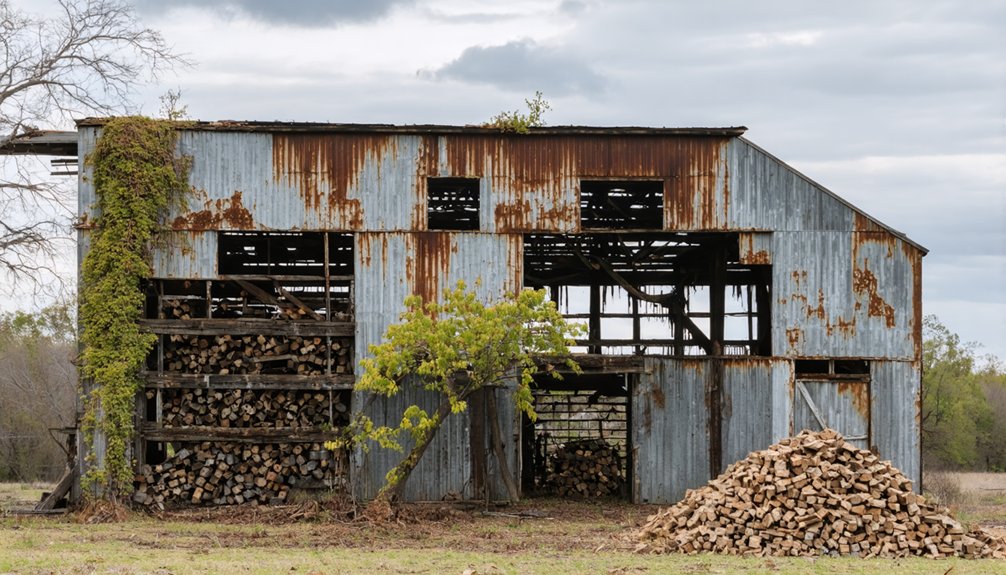
You’ll find the legacy of Daleville’s timber industry most evident in how the massive mill operations transformed the surrounding landscape, with production reaching over three million board feet annually by 1889.
The scale of timber extraction, which saw mills processing up to 20,000 board feet daily, eventually led to resource depletion that would shape future forestry practices throughout Arkansas. The Frisco Railroad line enabled efficient transportation of lumber and dramatically increased market access for timber operations.
Today’s second-growth forests around the former town site stand as living proof of both the industry’s impact and nature’s resilience, teaching valuable lessons about sustainable resource management.
Mill Operations Impact
The timber industry’s impact on Daleville left an indelible mark through its massive mill operations, which transformed both the landscape and local economy.
You’ll find that lumber production reached staggering levels, with mills churning out up to 50,000 board feet daily during the boom years. Northern timber entrepreneurs saw the potential in Arkansas’s vast pine forests, establishing operations that would forever change towns like Daleville.
The railroads you’d see cutting through the forests weren’t just transportation lines – they were lifelines of commerce.
Mills employed cutting-edge technology for their time, from steam-powered equipment to dedicated rail spurs. The industry’s reach extended far beyond Daleville’s borders, connecting the town to national markets and ushering in an era of unprecedented economic growth.
Sustainable Resource Management
While early timber operations in Daleville focused solely on maximum extraction, you’ll discover that sustainable forestry practices emerged as a crucial turning point by the 1930s.
The U.S. Forest Service‘s Southern Forest Experiment Station partnered with lumber companies to revolutionize resource conservation throughout Arkansas. You can trace this transformation at places like the Crossett Experimental Forest, where pioneering scientists developed new silviculture methods and regeneration techniques.
What you’re seeing today in Arkansas’s timber industry stems from those early sustainability efforts. Major corporations like International Paper and Georgia-Pacific now manage vast tracts of timberland using long-term yield strategies and ecosystem conservation principles.
It’s a stark contrast to Daleville’s boom-and-bust era, showing how sustainable forestry has become essential to the industry’s survival.
Remnants and Archaeological Findings
Modern visitors to Daleville will find little more than scattered foundations, an old cemetery, and crumbling remnants of what was once a bustling Arkansas mill town.
You’ll notice the archaeological significance of these ruins scattered throughout the rural landscape, particularly the old sawmill foundations that hint at the town’s industrial heritage.
While there haven’t been extensive archaeological excavations at the site, you’ve got the potential for fascinating artifact discovery throughout the area.
The remaining structures, though deteriorating, tell a compelling story of economic change and migration.
If you’re interested in exploring, you’ll find the cemetery is one of the best-preserved features, standing as a silent witness to the community that once called this place home.
The site’s untapped archaeological potential leaves room for future research and exploration.
Historical Landmarks and Tourism Today
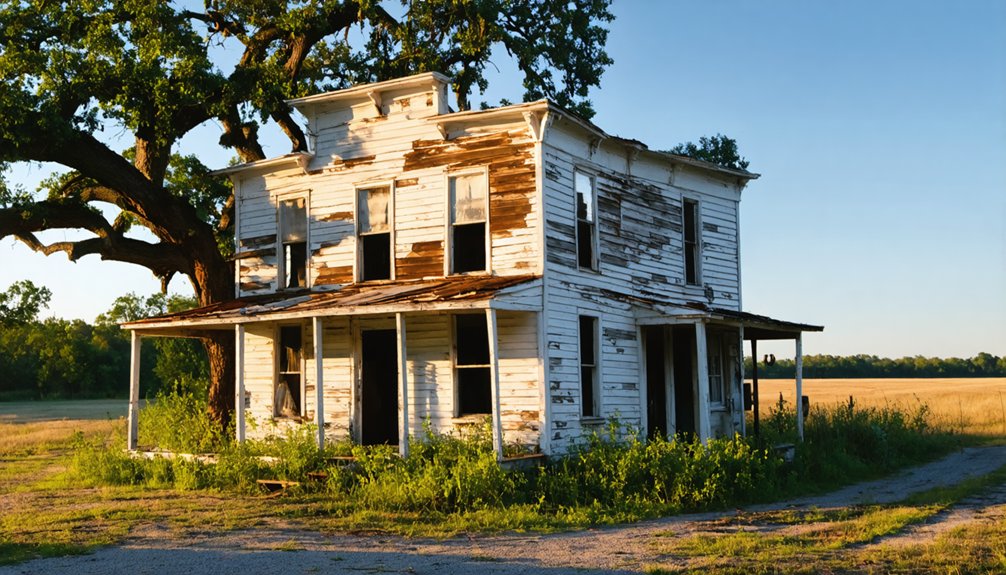
Standing prominently among Daleville’s scattered ruins, you’ll find the weathered remains of the Arkadelphia Lumber Company sawmill, a monument to the town’s industrial zenith in the 1880s.
Your ghost town exploration will reveal foundations of old mill buildings and houses scattered throughout the landscape, while an old cemetery nearby tells silent stories of the town’s former inhabitants.
Today, you can venture freely through this untamed site bordering the Ouachita National Forest, where historical preservation remains minimal but authentic.
While there aren’t formal tours or facilities, you’ll discover genuine ruins alongside opportunities for hiking and camping.
Just watch your step near the active railway tracks that still slice through town.
Unlike the more developed ghost town of Rush, Daleville offers you a raw, unfiltered glimpse into Arkansas’s industrial past.
Frequently Asked Questions
Are There Any Paranormal Activities Reported in Daleville’s Abandoned Buildings?
You won’t find documented ghost sightings or haunted locations in Daleville’s abandoned buildings. While its eerie atmosphere might spark your imagination, there’s no concrete evidence of paranormal activity in these ruins.
What Happened to the Residents After They Left Daleville?
You’ll find that when timber jobs dried up, residents’ relocation scattered families across Arkansas and neighboring states. Some moved to nearby mill towns, while others sought fresh opportunities in growing cities.
Is It Legal to Visit and Explore the Daleville Ghost Town?
A million times no – you can’t legally explore this ghost town without permission. The visiting regulations require landowner consent, and you’ll face trespassing charges if caught wandering the private property.
Were There Any Schools or Churches in Daleville During Its Peak?
You won’t find any schools or churches in Daleville’s history. The town’s workers and families relied on educational institutions across the Ouachita River in Arkadelphia for these essential services.
What Natural Disasters or Significant Events Affected Daleville Before Its Abandonment?
You won’t find records of major natural disasters affecting the town’s fate. While flood damage was possible near the Ouachita River, the real devastation came from economic decline when timber resources were depleted.
References
- https://www.thetravel.com/ghost-towns-in-arkansas/
- https://encyclopediaofarkansas.net/entries/daleville-clark-county-16105/
- https://arkansashistory.online/2020/06/10/graysonia-clark-county-ghost-town/
- https://kkyr.com/these-3-arkansas-ghost-towns-are-just-a-road-trip-away/
- https://www.discovervintage.com/ken/only-ghosts-remain-in-arkansas-mining-town/
- https://www.onlyinyourstate.com/experiences/arkansas/ar-ghost-towns
- https://www.youtube.com/watch?v=igmO24EMl8E
- https://en.wikipedia.org/wiki/List_of_ghost_towns_in_Arkansas
- https://www.ghosttowns.com/states/ar/daleville.html
- https://www.arkansasheritage.com/docs/default-source/ahpp-documents/sandwiching-tour-scripts/arkadelphia-chd-tour-script-2012796eecf6-61be-49aa-9eb9-c7b8c9f1fae8.pdf?sfvrsn=f7b9f9f8_5
